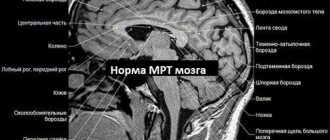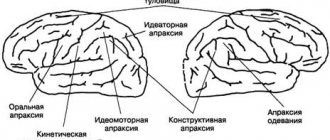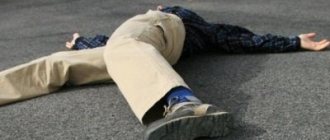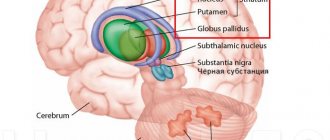Description
Tremor is a shaking-type movement of various parts of the body that occurs regardless of a person’s will.
In the vast majority of cases, the patient is bothered by vibrations of the upper limbs, as well as legs, neck or the whole body. Tremor is detected both as an independent disease and as a manifestation of another disease. Due to the difference in manifestations in the clinical picture of the disease, tremor of rest and movement is distinguished. Rest tremor occurs in the muscles of the limbs and trunk, which are not currently performing work. Movement tremor occurs during purposeful movements. Movement tremor, in turn, is of the following types:
- Postural. Appears when trying to maintain a certain position. Most often it manifests itself as trembling of outstretched arms in a standing position.
- Intentional. This type of tremor appears when making a movement for a specific purpose - picking up a mug, brushing your teeth, signing a signature. It is typical that the tremor intensifies as one moves toward the task at hand and especially after completing the movement.
- Kinetic. Appears only at the end of a targeted movement.
Tremor is not always pathological, that is, indicating the presence of some kind of disease. Physiological tremor is distinguished separately - oscillatory movements of various parts of the body when exposed to any external factors. Such factors may include: increased body temperature, excessive coffee consumption, fatigue, smoking, taking certain medications, hypothermia, physical activity, alcohol withdrawal syndrome, anxiety and panic conditions, poisoning with various pesticides, hypoglycemia and thyrotoxicosis. This type of tremor can be detected if the patient’s attention can be diverted. Usually, it is enough to ask him to perform some test for the tremor to become much weaker or disappear altogether. Physiological tremor manifests itself as intentional or postural tremor.
Physiological tremor disappears within a short period of time after the provoking factor has been eliminated. In some cases, it may be necessary to replace the medications the patient is taking, adjust hormonal levels, or work with a psychotherapist.
As a symptom, tremor occurs in various neurological diseases. These include: Parkinson's disease, multiple sclerosis, stroke, brain tumors, meningitis, peripheral neuropathy. To reduce the manifestations of tremor in this case, treatment of the underlying disease will be required. A metabolic disease such as Wilson-Konovalov disease (a disorder of copper metabolism in the body) will also be accompanied by tremors. In old and senile age, the main cause of tremor is Parkinson's disease.
Tremor also exists as an independent disease. This condition is called essential tremor. It manifests itself mainly in the form of intention and postural tremor. Essential tremor has an identified genetic predisposition to development and is not associated with any external factors. It manifests itself in the form of vibrations of the fingers and hands, especially when they make purposeful movements. In the later stages of the disease, along with trembling of the upper extremities, characteristic head movements can be observed - nodding or turning the head to the side (the “yes-yes” and “no-no” symptom). Essential tremor often has a favorable prognosis; it rarely causes disturbances in memory, thinking, and orientation in space and time.
Causes
Tremor of the body or its individual parts has not been fully studied. All the structures that are involved in the appearance of muscle tremors have not yet been fully identified. It is known that the nervous system initiates this process. Especially often it includes those departments that control muscle tone and movement. First of all, it is the cerebellum. This pathology is often accompanied by dizziness, as coordination is impaired. Sometimes the condition worsens when driving fast. This is due to dysfunction of the vestibular apparatus.
Tremor rarely acts as an independent disease. It accompanies neurological diseases. The reasons may be different. If your arms, legs, head, body begin to shake, anxiety, fear, muscle hypertonicity appear, the temperature rises, nausea appears, you should understand the root cause. Does trembling increase with load, tension, or change of position? This should be done by an experienced neurologist.
Sometimes shaking is a hereditary trait (essential type). A similar disease can occur in infants and even newborns. The child needs to be carefully examined. In other cases, this may be the result of a number of diseases and conditions (tumors, head injury, brain abscesses, hemorrhages, nerve pathologies).
The most common causes of pathology:
- overstrain (both physical and emotional);
- TBI;
- Parkinson's disease;
- thyrotoxicosis (excess of hormones produced by the thyroid gland);
- multiple sclerosis;
- liver or kidney failure;
- use of certain medications.
Tremors inside the body are divided into:
- intentional;
- postural;
- mixed;
- static.
Static tremor is observed in patients with parkinsonism, hepatocerebral dystrophy, poisoning (mercury), and essential tremor.
Postural tremor can cause poisoning (alcohol, lithium), parkinsonism, thyrotoxicosis. With alcohol poisoning in the morning, the patient often suffers from tremors in the limbs and cold sweat.
Internal body tremors can occur with anxiety or fatigue. At the same time, the body experiences increased stress, its strength quickly declines. The person appears to be healthy, but experiences serious discomfort. The tremor can also spread to the throat and vocal cords.
Sometimes this condition is provoked by a difficult pregnancy or regular toxicosis. The body becomes dehydrated and its strength dries up. At the same time, hormone surges also occur. The woman experiences anxiety, constant fatigue, weakness, and changes in blood pressure. She may unconsciously become depressed. This condition is especially common in the first trimester. Then this short-term discomfort passes safely, the body gets used to the new status.
Tremor can also be caused by a hormonal surge, for example, during menstruation, PMS.
Intention tremor occurs with cerebellar pathology. It may be accompanied by a headache or an unexpected fall. This condition is permanent. It requires the help of a surgeon.
Such vagueness in determining the causes and types of tremor is due to the fact that the mechanism of the process is at the stage of study.
Symptoms
Photo: medaboutme.ru
The main symptom of the disease is most often trembling in the hands, which appears when moving or trying to hold a certain position.
Tremors usually occur in two hands at once, or first in one, and after some time - no more than a couple of months - in the second. If the development of tremor on one hand is delayed, a difference in the amplitude of the trembling may occur, so the tremor will be asymmetrical. The tremor initially develops in the fingers, later the hands, forearms and shoulders become involved, then the trembling spreads to the head, and in some cases to the torso. Characteristic for patients with tremor will be speech impairment due to damage to the nerves that control the larynx.
Due to the development of tremor, patients experience difficulty in their usual daily activities. They are limited in their ability to eat, dress, or perform any hygiene procedures on their own. The development of tremor is a threat to continued work activity.
Kinetic tremors in the hands occur with a variety of movements, so it becomes impossible for the patient to perform even the most banal actions. It is only with great difficulty that they can pour a glass of water and drink from it, use cutlery, a pen and pencil, and a toothbrush. Kinetic tremor in the hands is manifested by involuntary flexion and extension of the fingers, hands, and forearms. With postural tremor, the shaking is less pronounced. If the tremor occurs against the background of the development of Parkinson's disease, the tremors will have a "twisting in a light bulb" type of tremor.
In the later stages of the disease, the vocal cords, muscles of the jaw, tongue, and lower extremities may be affected. Voice changes due to essential tremor rarely occur before age 60.
About a third of patients with tremor have gait disturbances, which include erroneous lateral steps. There is a dependence of walking disorders on the patient’s age, duration of the disease and the severity of tremor of the upper extremities.
Essential form: more details about treatment
Since the causes of tremor in both children and adults cannot be corrected, there is a need to prescribe symptomatic treatment, sometimes it is necessary to take quite potent drugs. The use of such drugs is associated with increased risks of intolerance. If the drugs mentioned above provoke such a response from the body, the doctor prescribes anticonvulsant medications. More often they are used by those whose active ingredients are primidone, hexamidine. If they are ineffective or unsuitable, they resort to topiramate and gabapentin.
In some cases, the doctor, explaining how to get rid of tremor, talks about the effects of levadopa. They may prescribe drugs with clonazepam or the administration of botulinum toxin A. If the condition is severe, all of the above remedies are ineffective, and neurosurgical therapy is necessary. It is necessary to stimulate the thalamic nuclei with electric current.
Diagnostics
Photo: demandstudios.com
A neurologist examines and treats patients with tremor. When collecting anamnesis, they try to find out how long ago and with what strength the tremor appeared, on which parts of the body. Special attention is paid to provoking factors, if the patient can identify them. If tremor suddenly appears, it is necessary to find out whether there have been head injuries earlier in life, and whether the patient has started taking a new drug.
A neurological examination necessarily includes an assessment of cognitive functions, cranial nerve function, movements, sensitivity, gait, standing position with arms outstretched with eyes closed, muscle strength and tone, and reflexes.
For a reliable diagnosis of essential tremor, a number of criteria have been identified. According to them, to make a diagnosis of essential tremor, the patient must have bilateral upper limb tremor for at least 3 years, and also be free of other neurological symptoms.
Essential tremor is a diagnosis of exclusion, that is, it is diagnosed only when all possible diseases that provoke this symptom have been discarded. Differential diagnosis is carried out with such diseases of the nervous system as: Parkinson's disease, multiple sclerosis, stroke, brain tumors, meningitis, peripheral neuropathy, brain abscess, alcoholic delirium, as well as Wilson-Konovalov disease and hyperthyroidism.
Head tremors in children
Relatively often, newborns and infants have muscle cramps, which manifest themselves in various parts of the body, incl. on the head.
Most often, tremor in a child is of a physiological nature. But sometimes it indicates a serious neurological pathology.
The main reason why a child’s head shakes is a disorder of the endocrine or nervous system. Tremor is the result of a number of fetal pathologies that develop at different stages and trimesters of pregnancy.
The most common reasons why children's heads shake:
- umbilical cord pathologies;
- hypoxia;
- infectious diseases of a pregnant woman (including influenza);
- premature placental abruption;
- dependence of a pregnant woman on alcohol or drugs;
- the presence of serious diseases during critical periods of the child’s formation (the first years of life);
- high levels of norepinephrine in the blood;
- prolonged crying, hysteria;
- underdevelopment of nerve endings;
- increased concentration of glucose in the child’s blood;
- decreased levels of calcium or magnesium ions in plasma;
- intracranial bleeding.
Physiological head tremor in children can sometimes persist from birth to puberty. It can manifest itself as twitching of the muscles of the face, tongue, chin; may twitch the eye. The condition is usually associated with excessive stress (usually shaking the head when excited) and is characterized by short-term attacks.
Pathological tremor is associated with a number of central nervous system pathologies. Seizures may occur during certain non-stress related activities. In addition to muscle contractions, symptoms of central nervous system dysfunction sometimes occur:
- headache;
- sleep disorders;
- excessive irritability.
Treatment
Photo: scleroman.ru
For mild manifestations of tremor, when it does not bother the patient, treatment is not carried out. If the fact of physiological tremor has been established, the main recommendation would be to avoid provoking factors: stress, smoking, overwork, excessive coffee, alcohol, and discontinue medications. Also, in case of physiological tremor, which causes anxiety in the patient, a course of medications may be prescribed.
Diagnosed essential tremor requires long-term drug therapy with dose selection. Treatment, in the first stages, occurs in a hospital setting, after which the patient is observed by a neurologist on an outpatient basis.
Symptomatic tremor that occurs against the background of Parkinson's disease, damage to the nervous system or other diseases serves as an additional factor for high-quality treatment of the underlying disease. In this case, an integrated approach to treatment is required, which will be aimed equally at both the tremor development factor and all symptomatic manifestations.
To treat tremors, it can sometimes be helpful to exercise the affected limb with weights and tense the muscles closer to the body while moving.
If severe tremor cannot be treated with medications, the use of surgical treatment methods is justified. Through neurosurgical intervention, different areas of the brain are affected that control passive movements and muscle tone. Often this practice is very effective, but a prerequisite for its use will be the preservation of the patient’s mental and mental functions. Neurosurgery is also effective for Parkinson's disease.
Possible complications
If mental abilities are preserved, there may not be any special complications of tremor for a long period of time. When the disease reaches a severe stage, attacks of trembling lead the patient to a decrease in the quality of life in general and loss of social communication. With improper or insufficient treatment, the pathological process spreads throughout the body. Uncontrolled movements become more intense and pronounced. A person experiences difficulties not only in a professional environment, but also in the everyday sphere.
The patient ceases to be able to work and cannot take care of himself without assistance. Tremor is a serious pathological process that requires immediate therapeutic treatment. The disease leads to dysfunction of the musculoskeletal system, curvature of the cervical spine, writing disorder, and severe speech defects. The motor amplitude gradually decreases. Against this background, unpleasant sensations arise in the cervical spine and constant headaches. The most severe complication of tremor is disability.
Medicines
Photo: alkotraz.ru
When you first contact a doctor and your symptoms are mild, medication may not be required. It may be sufficient to calm patients down and prescribe weak sedative pharmaceutical drugs (Corvalol, Hawthorn tincture, Valerian).
To treat manifestations of physiological tremor and chronic anxiety, drugs from the benzyldiazepine group (Diazepam, Lorazepam, Oxazepam) are used. Such drugs are prescribed in a short course, from 2 to 4 doses during the day. Beta blockers (Propranolol, Bisoprolol, Metoprolol) are effective in combating tremors caused by taking medications, which also help with rare episodes of increased anxiety.
For the treatment of essential tremor, a combination of the beta blocker Propranolol and the anticonvulsant Primidone is primarily prescribed. This combination of drugs is the most effective and safe for this disease. If after a certain time it becomes clear that the tremor does not go away when taking these drugs, Alprazolam, Atenolol, Sotalol, Topiramate or Gabapentin are added to them at the discretion of the doctor.
Tremors caused by Parkinson's disease can be successfully treated with Levodopa. Sometimes it is possible to prescribe drugs of the anticholinergic group (Vecuronium bromide, Pipecuronium bromide, Dioxonium), but often side effects such as dry mouth, decreased concentration, urinary and stool retention, dry eye syndrome prevail over the possible effects of treatment.
Cerebellar tremor
This is an intentional tremor, which under certain conditions turns into a postural tremor. A pathological condition is observed if the cerebellum or the connections of the organ elements are damaged. Most often, it transforms into postural syndrome if a person has multiple sclerosis. The frequency of the phenomenon is estimated at an average of 2.5 Hz. Limbs, head, body are affected. Development on one side or symmetrically is possible. Additionally, other features indicate cerebellar ataxia.
Since degeneration in the cerebellum is a severe process, it is very difficult to cure intention or postural tremor. The patient is prescribed a therapeutic program consisting of gymnastics that is most suitable for the identified disorder. This helps relieve symptoms. To make the limbs heavier, it is recommended to use bracelets, the weight of which can reach 0.8 kg. The doctor prescribes medications. They use products that contain pregabalin, primidone, and finlepsin. Pharmaceutical products containing ondansetron, diazepam, and isoniazid are known for their effectiveness.
Folk remedies
Photo: tutknow.ru
Folk remedies cope well with physiological tremor, which is caused by stress and physical fatigue. To improve your well-being after exercise and reduce anxiety, you can use the following methods.
- Oat decoction. Prepare for the entire course of treatment at once. For one liter of water you need to take 100 grams of oats, boil and leave overnight. Drink one glass on an empty stomach in the morning. Continue this way for 5 days, after which you need to take a break. Repeat the dose in a week if the attacks have not passed.
- Decoctions of medicinal herbs. Tea with the addition of valerian, heather, chamomile, and motherwort are excellent for combating tremors and anxiety. If possible, brew the herb in a thermos and let it brew for at least an hour. Take one tablespoon of dry herb per glass of water. The good thing about this recipe is that you can consume the herbal decoction every day.
- If you have frequent tremors, you can drink the juice of tansy flowers. Squeeze the juice from 2-3 flowers into a glass of water, or simply chew it, but do not swallow the pulp.
Hot baths with essential oils and herbs are great for comfortable relaxation. It is recommended to take a bath before bed, adding a few tablespoons of essential oil of lavender, mint or other soothing plants, or a couple of glasses of decoction of valerian, heather, chamomile, motherwort, lemon balm.
A massage helps you relax after heavy physical activity. Even a non-professional massage of the main muscle groups of the back, upper and lower extremities has a beneficial effect on blood circulation, helps to relax and relieve fatigue.
The information is for reference only and is not a guide to action. Do not self-medicate. At the first symptoms of the disease, consult a doctor.
The main thing that older people need to know:
Many older people don't see a doctor because they think tremors are part of the normal aging process. This is the wrong approach. You need to see a doctor: the doctor will conduct a physical examination, talk with the patient and find out the possible causes of the tremor. Your doctor can then provide helpful tips on how to live with tremors and may prescribe medications to help relieve them.
In addition, older people take many medications and are more susceptible to their side effects. Some medications may cause tremors in the limbs. When prescribing this medicine to an elderly person, the doctor tries to choose the lowest effective dose. This dose may be lower than those used to treat younger patients. In older people, doctors avoid the use of drugs that have anticholinergic effects whenever possible.
Tremor can significantly reduce the quality of life of older people and their ability to perform various activities. This is especially significant if the tremor is accompanied by physical or mental disorders. Exercise and occupational therapists can offer older patients simple ways to manage tremors and assistive devices that improve quality of life.
What can tremor be confused with?
Tremors cannot always be correctly identified at home. To do this you need to have a medical education. After all, there are several other pathological phenomena that are easily confused with tremor.
What you need to be able to distinguish tremor from:
- Asterixis. With this pathology, rapid fluttering movements occur. They have a high amplitude and occur with prolonged muscle tension. You can detect this type of shaking by extending your arms and bending the backs of your hands. In this case, rapid irregular flexion movements of the fingers and hands will be observed. This symptom occurs with metabolic disorders and dysfunction of the liver and kidneys.
- Clonus. These are rhythmic unidirectional muscle contractions. In this case, only agonist muscles are involved in this process. This pathology occurs when the cortical-cerebral pathway is damaged.
- Myoclonus. With this pathology, individual muscles or muscle groups contract. At the same time, the contractions are very fast. They can be present for a long time in the same area of the body.
- Polymyoclonus. With this pathology, rapid asymmetric muscle contractions are observed. Moreover, they are localized in many parts of the body. Caused by various metabolic disorders, as well as epilepsy.









